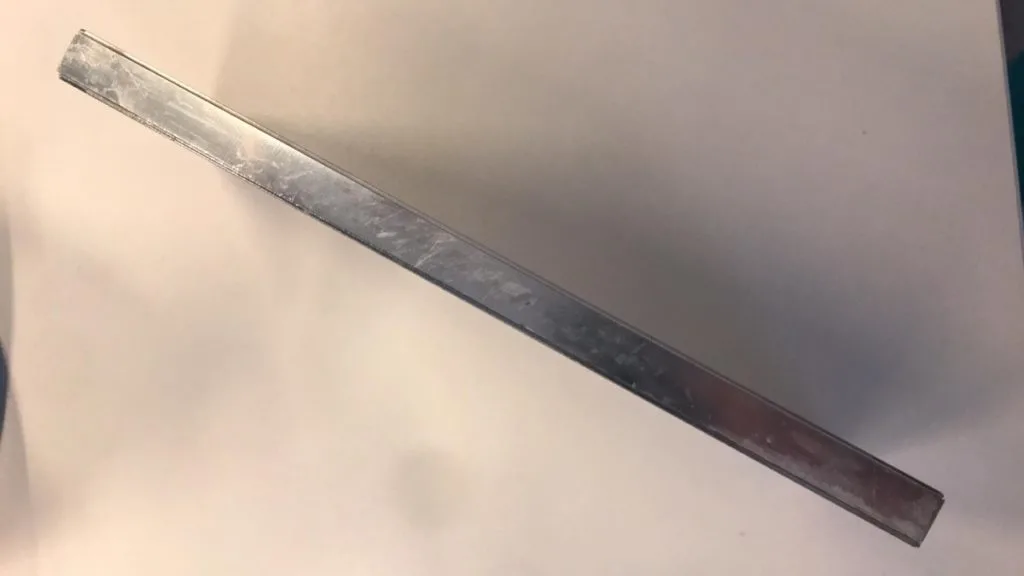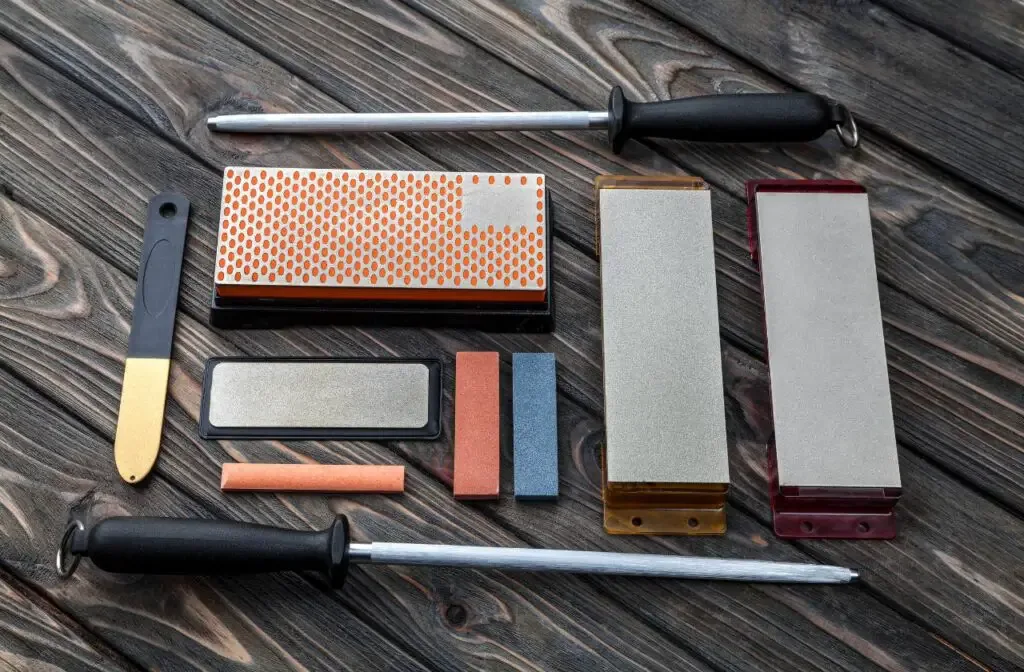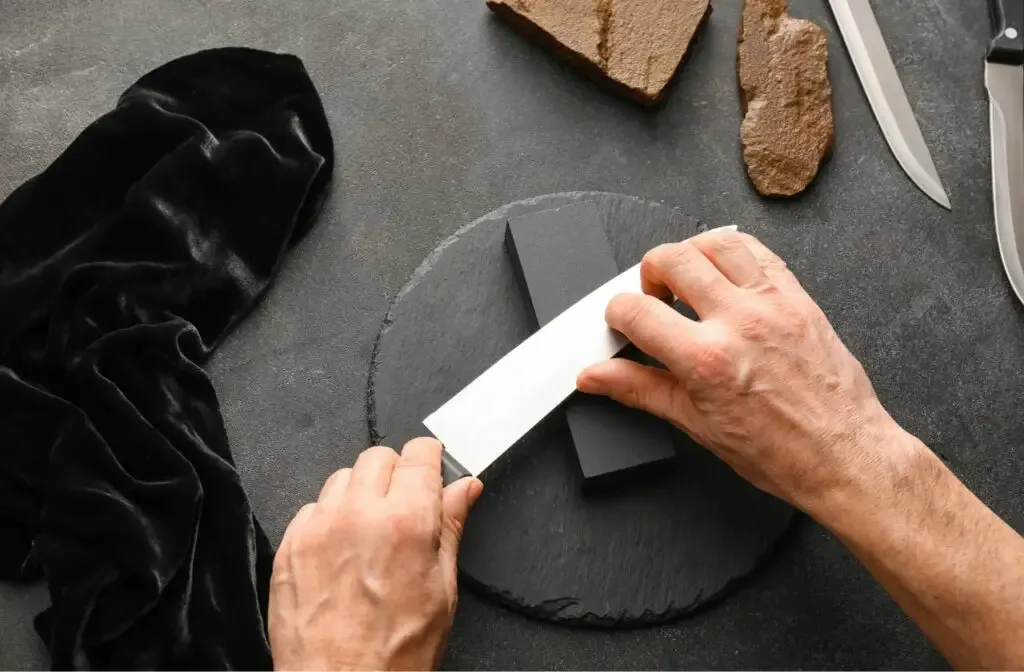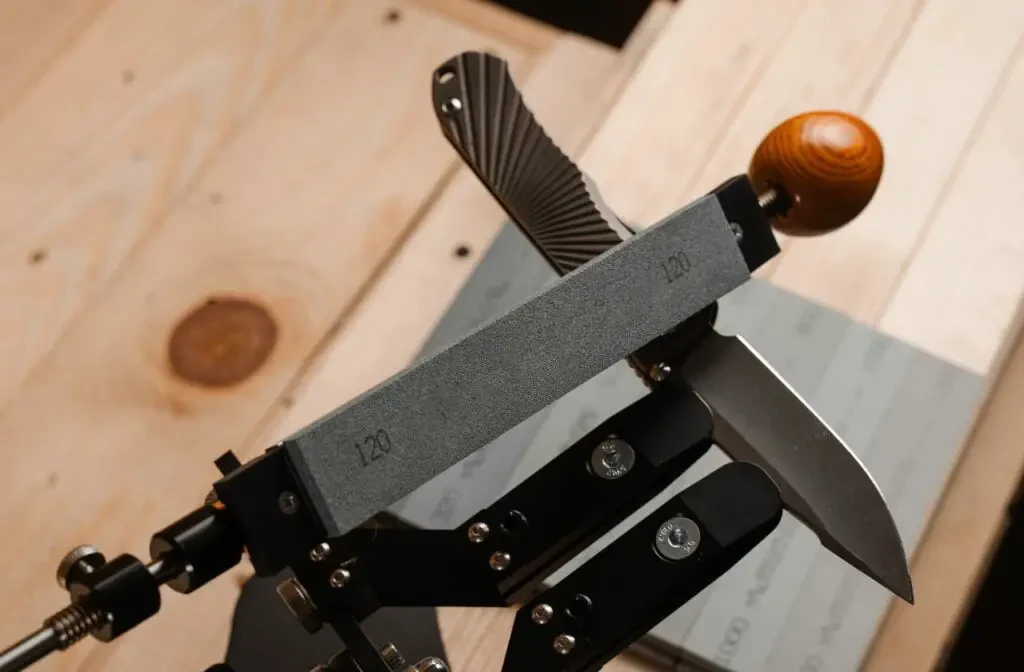As an Amazon Associate, we earn from qualifying purchases with no additional costs for you.
The introduction of diamond stones to the world of knife sharpening has brought many advantages. Diamond stones have some benefits that may fit better with your sharpening needs, prompting you to use this sharpening medium. How Do You choose and use diamond stones to sharpen your knives like a pro?
Diamond stones use industrial diamonds as the abrasive material. They can be used dry, but it is recommended that water be used as a lubricant. Diamond stones do not need flattening, and the same sharpening techniques used on other whetstones can be used on diamond stones.
Diamond knife sharpening stones use industrial-grade diamonds as the abrasive media on a solid backing material. They are generally shaped similarly to traditional water stones in a rectangular format. We will demonstrate the best way to use these stones and how to choose your own set of diamond sharpening stones.
If you are interested in checking out the best diamond sharpening stones (Atoma) you can find them by clicking here (Amazon link).

How To Use A Diamond Stone To Sharpen A Knife
Diamond sharpening stones are sometimes referred to as diamond stones or diamond whetstones, but they all refer to the same type of diamond stone.
Diamond sharpening stones can be used similarly to normal sharpening stones, which includes the following process.
- Select the starting grit.
- Establishing the correct sharpening angle.
- Sharpening one side to establish a burr, repeating on the opposite side.
- Repeat with each diamond stone grit.
Diamond stones are available in a variety of designs and shapes. They can be used in pull-through sharpeners, honing rods, or sharpening systems; however, the diamond stones we will be referring to here are the type in the rectangular format, similar to normal whetstones.
Select The Diamond Stone Starting Grit
Not all sharpening jobs require the same level of aggression to achieve a good result. The knife blade should be examined to decide the starting grit for the process.
If the knife has been sharpened recently, it may only require a few passes over the fine stone to hone the edge. Conversely, if the edge is damaged, you may need to start with a coarse grit to repair the edge.
If the knife has not been sharpened in a while, it may need a sharpening, which would require starting with a medium grit stone.
TIP: If you are looking to buy a diamond sharpening stones set, we always recommend the Atoma set. The stones in the set 1 x 140-grit, 1 x 400-grit, 1 x 600-grit, and 1 x 1200-grit (Amazon links).
Find The Sharpening Angle for The Knife On The Diamond Stone
Secure the diamond stone securely on a worktop in front of you. Wet the diamond stone with a little water. A spray bottle filled with water works well for this.
Lay the knife blade on the stone, and place the fingers of your non-dominant hand. Gently lift the blade till you feel the secondary bevel engage or make contact with the stone’s surface.
This is the angle you should maintain throughout the sharpening process through all the diamond stone grit progressions.
Start The Sharpening Process On The Knife
The technique used to sharpen knives on a diamond stone is exactly the same as on other whetstones, so if you have some experience on other stones, the skills you developed will translate over to the diamond stones.
Establish the angle of the knife on the stone. Position the knife at the far end of the stone with the sharp edge facing away from you. Starting at the knife’s heel, draw the knife towards you across the stone from heel to tip, maintaining the angle throughout the stroke.
Always draw the knife across the stone towards the knife’s spine and away from the cutting edge. Never push the cutting edge forward across the stone. This can gouge chunks out of the knife’s edge.
As you draw the knife over the diamond stone, the water on the stone will be displaced and pushed off the stone. Use the spray bottle to periodically spray more water over the sharpening stone.
Work the same side of the knife on the diamond stone until you feel a burr developing on the opposite edge. At this point, you will turn the knife over and begin sharpening the opposite side.
To sharpen this side of the knife, start on the end of the stone closest to you, with the cutting edge facing you. This time, start at the tip of the knife and push the knife across the stone away from you, moving the knife from tip to heel across the stone.
Repeat the process on this side of the knife until you feel the burr develop on the opposite side again. At this point, it is time to move to the next level of grit sharpening stone .
You can work alternating sides of the knife until the burr has disappeared from the edge when you get to the finest grit stone.
At this point, the knife is sharp, and you can run the knife over a strop for a final touch-up of the edge!
TIP: Are you looking to buy diamond sharpening stones? You can find a lot of cheap and low-quality diamond stones on the market, so you need to be careful when buying them. Check out the complete buyer’s guide in the article below:
Buyer’s Guide: Best Diamond Knife Sharpening Stones Set
What Grit Diamond Stone Do I Need?

As with any knife sharpening system, you will need different grits to perform different tasks on the blade edge. This principle holds true for the use of diamond sharpening stones as well.
There are essentially three tasks that you can perform on a knife with any whetstone type, including diamond stones.
- Repairing the knife edge with a coarse grit.
- Sharpening the knife edge with a medium grit.
- Honing the knife’s edge with a fine grit.
Each of these three tasks will require a different grit level. Repairing an edge on a knife will require the most aggressive or coarse grit. Honing will require a fine-grit diamond stone, and sharpening will be somewhere in between.
While it is possible to have 7 or 8 different grits of diamond sharpening stones, and you may get to that point as you progress with your sharpening, you essentially need only three grits to start off with.
What Diamond Stone Grit Do You Need To Repair A Knife Edge?

Repairing a knife edge to remove chips and gouges requires an aggressive, coarse grit diamond stone to remove a lot of metal from the knife’s edge in a short time.
If you are new to sharpening or sharpening with diamond stones, we recommend that you choose one stone to start off with, which is a 250-grit diamond stone. The 250-grit will give you the most versatility in the range and allow you to fix the most damaged edges.
Typically, the grits used for this type of work on the blade are between 120-grit and 400-grit. Many knife owners experienced in this task will have a couple of stones in this grit range to cater to the severity of the damage to the blade’s edge.
What Diamond Stone Grit Do You Need To Sharpen A Knife?
Sharpening a knife with a diamond stone requires a mid-range grit that is less aggressive or coarse than the stone used to repair an edge. Sharpening requires less material removal but still enough to re-establish the secondary bevel on the blade.
For most sharpening functions, a diamond stone in the grit range of 600-grit to 1000-grit is required to perform the sharpening function. To select one stone from this range, you need to choose the one that will offer the most versatility for the sharpening function. This would be the 600-grit stone.
The 600-grit diamond sharpening stone will be the most useful for the sharpening process since it will handle the widest range of sharpening tasks.
You can expand your collection of diamond stones as you progress to include an 800-grit and a 1000-grit stone to have a prime set of sharpening stones.
PRO TIP: We personally use diamond plates by Atoma. They are quite expensive but of the top quality with very long service life.
The initial costs are higher but you have an option of buying replacing diamond skin for all Atoma plates. The costs of replacing diamond skin are much lower than the cost of buying a new diamond plate.
So if you are going to use diamond plates regularly and want to get the best quality on the market, check out the four Atoma diamond plates listed below (Amazon links).
- Atoma Diamond Sharpener Coarse Grade 140 Grit
- Atoma Diamond Sharpener Medium 400 Grit
- Atoma Diamond Sharpener Fine 600 Grit
- Atoma Diamond Sharpener Super Fine 1200 Grit
These 4 diamond sharpening stones are all you need to have for repairing or sharpening your knives.
What Diamond Stone Grit Do You Need To Hone A Knife?
Honing or refining the edge after sharpening is one of the final steps in sharpening a knife. The honing process removes the burr established on the cutting edge during the sharpening process and serves to refine and polish the edge.
The diamond stone grits typically used for the honing process are between the range of 1200-grit and 1500-grit. The recommendation for the single most useful diamond stone in this grit range is the 1200-grit. This stone offers the most versatility for the honing process.
To select a single stone from this range, we recommend a 1200-grit diamond stone as the best choice. This stone will not put a mirror finish on the edge, but it will polish the edge sufficiently for most knife-sharpening applications.
As with the other grit ranges, you can expand your honing diamond sharpening stones to include finer grits, but they are generally unnecessary for average knife sharpening needs. Usually, a 1200-grit finish is sufficient, followed by a few passes over a leather strop with a fine-grit compound.
TIP: Diamond stones are the best option when sharpening stainless knives. Check out the DIY guide on how to properly sharpen stainless knives with diamond stones in the article below:
DIY Guide: Best Way To Sharpen A Stainless Steel Knife
Do Sharpening Stones Need To Be Flattened?

Diamond stones are constructed differently than traditional whetstones. The diamond abrasive is bonded to the surface of a rigid material, which does not become worn away unevenly with use.
Diamond stones do not need to be flattened. The solid base the diamond abrasive is bonded to does not wear away or develop dishing from uneven wear. Diamond stones are often used to flatten other whetstones. As the diamond stone wears down, it will become less effective, but it won’t distort.
You will know a diamond stone needs replacing when the stone no longer cuts as effectively and efficiently as it used to. At this point, the diamond abrasive has worn to the extent that the stone should be replaced, but this can take many years with a quality stone.
Do You Wet A Diamond Sharpening Stone?
Most standard sharpening whetstones require some form of liquid to use the stones to sharpen a knife. This is where diamond stones are different; they can be used dry, but there is a caveat to this statement.
Diamond stones can be used dry, but it is recommended that water be used as a lubricant on diamond stones to wash the waste steel, or swarf, away from the abrasive during the sharpening process. This will keep the diamond stone cutting effectively throughout the sharpening process.
Diamond stones can be used dry, which is advantageous for use in the field if you don’t have any water available to lubricate the stone.
However, a diamond stone used dry will deteriorate the efficiency with which the abrasive will cut the steel.
This is due to the build-up of waste material on the diamond stone that the water would normally wash away from the stone’s surface. Washing the diamond stone with water after use will restore the cutting ability of the diamond abrasive.
Using a diamond stone dry would only be appropriate if you are in the field and use a pocket diamond stone to touch up the sharpness of the blade. However, once you have access to water, you should wash the stone off to maintain its sharpening effectiveness!
TIP: Diamond stones can be used dry, but other types of whetstones need to be wet when you are using them. Check out what stones and why they need to be wet when sharpening in the article below:
Do Sharpening Stones Need To Be Wet? Complete Breakdown
Do Diamond Sharpening Stones Need Oil?
Oil as a lubricant has been associated with a particular type of sharpening whetstone, generally referred to as oilstones.
Oil will work as a lubricant on a diamond stone, but it is not recommended. Diamond stones do not absorb the oil in the same way that stones absorb the oil, so the oil does not provide any long-term benefit to a diamond stone; it simply makes cleaning the stone more difficult!
Normal whetstones made from stone have pores in the stone that absorb the oil. If the right oil is used, it remains in liquid form in the pores and provides lubrication during the sharpening process on the stone.
Since diamond stones do not possess pores for the oil to soak into, the oil will provide lubrication for the current sharpening job but not for subsequent sharpening since the oil must be cleaned from the stone.
If you use oil on your diamond stone, ensure that you use an oil that will not coagulate or harden. Mineral oil would be the best oil choice to use on a diamond stone due to its low viscosity, and it will not harden on the stone.
Diamond Sharpening Stones Vs. Other Whetstone Types

When maintaining the sharpness of your knives, choosing the right sharpening stone is pivotal. Diamond sharpening stones have become a popular choice for most enthusiasts, but how do they stack up against other types of sharpening stones regarding efficiency and longevity?
Diamond sharpening stones are renowned for their hard-wearing and durable nature. These sharpening stones boast industrial-grade diamonds as their abrasive media, ensuring a swift and efficient sharpening process.
Unlike natural whetstones or oil stones, diamond stones don’t necessitate prolonged soaking or elaborate preparation. Their ability to quickly restore the sharpness of blades, even those made from hard steel, is unparalleled.
Diamond sharpening stones are very durable and long lasting, often outliving their counterparts. The hardness of diamonds ensures that these stones do not wear down or lose their flat surface as rapidly as natural or synthetic stones.
This type of sharpening stone is more expensive to buy than others, but the extended lifespan of diamond stones often validates the cost, providing a sustainable sharpening solution for avid cooks and professional chefs alike.
Diamond sharpening stones exhibit a remarkable versatility, as they are capable of sharpening a myriad of tools beyond kitchen knives. Their ability to handle various materials and tools without losing efficacy makes them a multifaceted choice for sharpening needs across different domains.
Maintenance is another arena where diamond stones shine. They do not require flattening and are relatively easy to clean, ensuring that they remain effective and reliable over time. The low-maintenance aspect is particularly beneficial for individuals who require a straightforward, no-fuss sharpening tool.
While traditional whetstones, ceramic stones, and oil stones have their own merits, diamond sharpening stones often emerge as a preferred choice for those prioritizing efficiency and durability. However, the choice of sharpening stone may also be influenced by the specific knives and tools you intend to sharpen, your budget, and your sharpening skill level.
Diamond stones have established themselves as a robust, efficient, and enduring option. Whether you’re a culinary expert seeking a reliable sharpening tool or a hobbyist exploring efficient sharpening for various tools, understanding the unique attributes of different sharpening stones, including diamond stones, is crucial to making an informed decision tailored to your needs.
Conclusion
Diamond stones are one of the easiest whetstone types to use because they require less maintenance and last much longer than other whetstones.
The techniques used to sharpen a knife on a diamond stone are exactly the same as on other whetstone types, making techniques and skills transferable between the different stone types.
The main disadvantage is that diamond stones can be considerably more expensive than other whetstones. However, they are still cheaper than authentic Japanese Waterstones, making them a good alternative, quality, sharpening stone.
TIP: It is important to clean and store your diamond sharpening stones after knife sharpening properly. Find out the complete guide on how to care about diamond stones in the article below:
Diamond Sharpening Stone: Explanation, Cleaning & Storage
